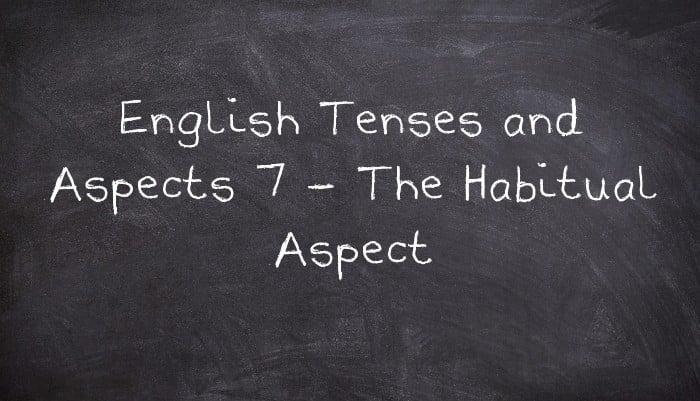English Tenses and Aspects 7 - The Habitual Aspect
7.1. Traditional used to
Writers find used to difficult to classify; a variety of labels have been used for iti. I believe that considering it as the (marked) habitual aspect (cf. Aarts (2011.273-4)), as I do in this article, makes it a natural part of the English tense aspect system. However, classification is irrelevant to learners - they need to how to use and understand a structure, not what to call it. The shortness of this article suggests that it is not a difficult form to use.
The traditional explanations of used to are:
……1. A discontinued past habit: I used to play a lot of rugby (but I don’t any more).
……2. A discontinued past state: George used to be a miserable character (but now he isn’t).
7.2. The Habitual ‘Rule’
The traditional explanations are in accord with the rule presented here for the habitual aspect:
We use the habitual aspect when we wish to indicate that a habitual past situation is no longer actualised (as a habitual situation).
This use contrasts neatly with the simple marked form:
……1. I used to play a lot of rugby (but I don’t any more).
……1a. I played a lot of Rugby in the 1980s. (I may or may not still play rugby; that is not part of the message conveyed.)
As we have seen in previous articles, the marked form of the verb can distance the situation in time, reality or directness. Distancing in time is usually made explicit by some form of time marker, as in [1a], in the 1980s. The habitual aspect has the dual function of locating the habitual situation in past time and of emphasising its non-actualisation now. The past time period is not specified except in the most general terms:
……3a. * I used to build model planes in 1994.
……3b. I used to build model planes.
……3c. I used to build model planes when I was a kid.
In [3a], one point of interest is the specified time period. This does not fit well with the habitual but discontinued idea conveyed by used to, and the simple marked form of the verb would be used here. [3b] is a natural use of the habitual aspect; with no specific past-time marker, the marked form of the verb would be unnatural. In [3c], the time period is broad enough for the habitual aspect to be possible; as there is a specific time marker, the marked form would also be possible, but it would lack the discontinued idea of the habitual aspect.
One anomaly of this form is that, when used with DO-support, some people use use, others used:
..…4. I didn't use(d) to like garlic.
……5. Didn't you use(d) to go out with Julia?
This is apparent only in writing. In speech, use to and used to sound the same.
i For some it is a modal (auxiliary)(verb) (Alexander (1988.234)), for others a phrasal modal (Celce-Muria and Larsen-Freeman (1999.139)), semi-modal (Carter & McCarthy (2006.638)), marginal modal (Biber (1999.73), Quirk et al (1985,137)), marginal auxiliary (Christophersen and Sandved (1970.231)), (quasi/semi) auxiliary (Declerck (2006.34), Joos (1964.29). Palmer, 1965.162)), anomalous finite (Hornby (1954.2)) or even iterative aspect auxiliary (Curme (1931.387)).
